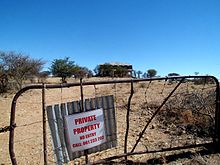Liebig House (Namibia)
| Liebig house | ||
|---|---|---|
|
National monument in Namibia |
||
| Monument type | monument | |
| location | west of Windhoek | |
| Geographic coordinates : | 22 ° 36 '30.6 " S , 16 ° 43' 5.8" E | |
|
|
||
| Emergence | 1911 | |
|
Recognized by the National Heritage Council |
? | |
| Deprivation | ? | |
| Sponsorship | Private | |
| Website | ||
The Liebig House , also known as the Haunted House , is a former residential house on the Neuheusis ( ǁHoeses ) farm , about 42 km west of Windhoek in the Khomashochland in Namibia . The building was erected in 1911 and was a National Monument .
history
In September 1907, LEMCO ( Liebig's Extract of Meat Company ; today the stock cube company Oxo ) acquired more than 200,000 hectares of land. The so-called Liebig House was built here in 1911, named after the chemist Justus von Liebig . In the following years, high-ranking employees of the company were housed here.
The location of the house was chosen because of its exposed location and good all-round visibility.
In 1939 the South African government purchased the farmland from the Liebig company in order to divide it into 65 farms and thus create land for new settlers.
In 1945 the house was given to the family of the famous photographer Margaret Courtney-Clarke . In 1964 Wilhelm Hoff bought the Neu Heusis farm. Since then the house has been empty and in ruins. The well-known name Geisterhaus results from this . The house, clearly visible from the main road C28, is located on fenced private farmland; Access is only possible with the approval of the owner.
literature
- Andreas Vogt : National Monuments in Namibia. An inventory of proclaimed national monuments in the Republic of Namibia. Gamsberg Macmillan, Windhoek 2004, ISBN 99916-0-593-2 .
Remarks
- ↑ Note: This article contains characters from the alphabet of the Khoisan languages spoken in southern Africa . The display contains characters of the click letters ǀ , ǁ , ǂ and ǃ . For more information on the pronunciation of long or nasal vowels or certain clicks , see e.g. B. under Khoekhoegowab .



